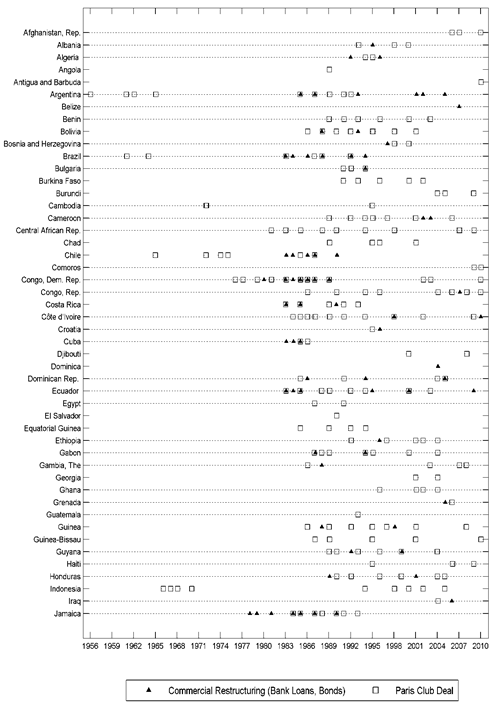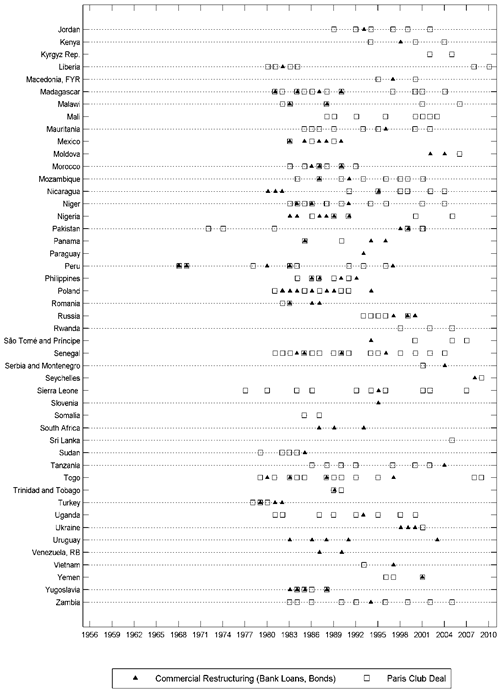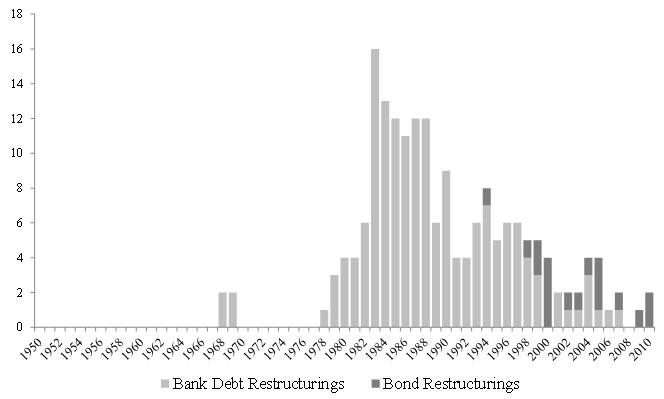Reinhart and Rogoff (2009) provide an impressive account of the history of sovereign debt crises over the past 200 years. However, they do not discuss the patterns of crisis resolution in detail. How frequent are sovereign debt restructurings? What amounts have been restructured? How long does it take to restructure sovereign bonds or loans? What are the typical pitfalls in the restructuring process (creditor litigation or holdouts)? How do governments communicate with their creditor banks and bondholders? What is the scope of debt relief, or 'haircuts', in past restructurings? These important questions remain largely unanswered until this date and empirical research remains scarce (notable exceptions include the work by Eichengreen and Portes 1989 and Benjamin and Wright 2009).
One reason for our limited knowledge on debt crisis resolution is a lack of data. No institution has been responsible to collect systematic databases on the issue. In this column, we present new evidence from Das et al. (2012) on the history of sovereign debt restructurings between 1950 and 2010 in developing and emerging-market countries.
Sovereign debt restructurings as recurrent events: A census for 1950-2010
Figure 1 shows the results of a 'census' of sovereign debt restructurings between 1950 and 2010, which was constructed by Trebesch (2011). It is evident that some countries have undergone repeated rounds of debt renegotiation, a pattern that resembles the notion of 'serial default' by Reinhart and Rogoff (2009). Debt restructurings come in 'bunches', in particular the 1980s saw a wave of debt restructurings with private creditors. In contrast, there were barely any restructurings in the 1960s and 1970s.
More specifically, between 1950 and 2010, there have been more than 600 sovereign debt restructurings in 95 countries. From these, 186 debt exchanges have been with private creditors (foreign banks and bondholders), while 429 agreements restructured bilateral debt with the Paris Club. This means that the Paris Club implemented more than twice as many restructurings. Interestingly, however, private creditors were more affected in terms of restructuring volume: $768 billion of debt owed to private creditors was restructured, compared with $545 billion treated by the Paris Club.
Figure 1. Foreign sovereign debt restructurings (1950-2010)
Source: Trebesch (2011).
An anatomy of sovereign debt crisis resolution
How were sovereign debt crises resolved in the past? And what can we learn from these experiences? The data show that the large majority of crisis cases involved restructurings that exchanged old debt instruments into new ones. Only 26 crisis cases involved formal debt buybacks, meaning the exchange of old bonds or loans into cash at a discount. However, not every default was followed by a restructuring. There have been more than a dozen instances in which governments temporarily miss payments, which are eventually repaid. This means that a default is resolved (or 'cured') without debt renegotiations.
One can also categorise debt crises cases by the type of debt exchange. Figure 2 shows that bond restructurings (re-)emerged only after the Brady plan of the mid-1990s. Of the 186 debt exchanges with private creditors, 168 cases affected bank loans, while only 18 were sovereign-bond restructurings. Regarding creditor losses, 57 restructurings involved a cut in face value (debt reduction), while 129 only implied a lengthening of maturities (debt rescheduling). However, both types of debt operations can involve a 'haircut' in present value terms.
Figure 2. Bank debt restructurings versus bond restructurings (1950–2010)
Note: The y-axis plots the number of finalised restructurings per year.
Source: Trebesch (2011).
The current system of ad hoc restructuring: What the record says
Regarding the restructuring process, recent years have seen the emergence of a new system of ad hoc restructuring of sovereign bonds. Typically, the procedure involves a unilateral restructuring offer launched via press releases and an offering memorandum with a menu of options and a mix of 'carrot' and 'stick' features. The offer is often preceded by formal or informal creditor consultations. All available evidence suggests that these main steps in bond restructuring are similar for all types of debt, whether domestic or external, private or public. Relatedly, we find that 'twin restructurings' of both foreign and domestic bonds have become the norm in crises of recent years.
There are well-known pitfalls in the restructuring process. The data show, however, that most bond exchanges since the mid-1990s have been smooth, in the sense that they were implemented quickly and with a creditor participation rate exceeding 90%. Creditor coordination problems, such as litigation and holdouts, seem not to have been a major problem in most cases, despite widespread concerns about these issues (e.g. Bi et al. 2011). Relatedly, there is no evidence of an increasing trend in inter-creditor disputes since the 1980s. Two notable exceptions are the debt renegotiations in Argentina (2005) and Dominica (2004), which took more than two years to complete and saw a 'run to the courthouse'. In Argentina, the legal disputes continue to this date.
To conclude, we find that debt restructurings with close creditor consultations were often quicker and more orderly than those with no prior negotiations. In particular, early market sounding and roadshows tend to coincide with a high degree of creditor participation in the exchange. These experiences may prove instructive for any distressed country, including for advanced economies.
References
Benjamin, David, and Mark L J Wright. (2009), “Recovery before Redemption: A Theory of Delays in Sovereign Debt Renegotiations”, mimeo, UCLA..
Bi, Ran, Chamon, Marcos and Jeromin Zettelmeyer (2011), “The Problem that Wasn’t: Coordination Failures in Sovereign Debt Restructurings”. IMF Working Paper 11/265.
Das, Udaibir, Papaioannou, Michael and Christoph Trebesch (2012), "Sovereign Debt Restructurings 1950 - 2010: Literature Survey, Data, and Stylized Facts", IMF Working Paper 12/203, International Monetary Fund.
Eichengreen, Barry and Richard Portes (1989), Setting Defaults in the Era of Bond Finance, World Bank Economic Review, 3(2): 211-39.
Reinhart, Carmen and Kenneth Rogoff (2009), This Time is Different: Eight Centuries of Financial Folly, Princeton: Princeton University Press.
Trebesch, Christoph (2011), “Sovereign Debt Restructurings 1950-2010: A New Database”, Unpublished Paper, University of Munich.
1 This database can be downloaded at https://sites.google.com/site/christophtrebesch/data








